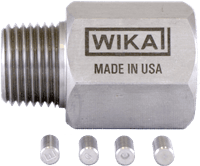Pressure Snubbers & Dampeners
Pressure snubbers are used to protect pressure gauges, sensors, transducers, and other pressure-sensitive instruments from sudden spikes or fluctuations in pressure. They act as a dampening mechanism, slowing down the rate at which pressure changes are transmitted to the measuring instrument, thereby preventing damage, reducing wear, and enhancing the accuracy and longevity of the instrument.
The pressure snubber contains a dampening element that restricts the flow of the process fluid into the pressure instrument. This element can be a porous material (like sintered metal), a piston with a small orifice, or an adjustable needle valve. The dampening element effectively reduces the impact of sudden pressure surges by creating resistance to rapid fluid flow. The body or housing of the pressure snubber is typically made of durable materials such as stainless steel, brass, or other alloys, chosen based on compatibility with the process fluid and environmental conditions. The snubber has two connection ports: one connects to the pressure source (such as a pipe, tank, or pump), and the other connects to the pressure gauge, transducer, or sensor being protected.
A pressure snubber works by inserting a flow restriction between the pressure source and the instrument, when there is a sudden spike in pressure, the restriction slows down the rate at which the pressure is transmitted to the instrument, dampening the rapid fluctuations. This process protects sensitive components within the gauge or sensor from mechanical damage due to pressure shocks or pulsations and helps stabilize the pressure reading.
Types of Pressure Snubbers
Fixed-Orifice Snubbers have a fixed, non-adjustable orifice size that restricts fluid flow. These are simple and cost-effective but may not be suitable for applications where pressure fluctuations vary significantly or require fine-tuning.
Adjustable Snubbers feature an adjustable mechanism, such as a needle valve, allowing the user to change the orifice size to control the level of dampening. These snubbers are more versatile and can be fine-tuned for different pressure ranges and fluid types.
Porous Element Snubbers utilize a porous element (like sintered metal) to create resistance to fluid flow. The porosity provides a consistent level of dampening across a range of pressures and fluids. These are commonly used in applications with fine particulates or where consistent dampening is required.
Pressure snubbers are used to protect gauges and sensors in hydraulic and pneumatic systems from pressure spikes caused by rapid valve actuation, pump starts/stops, or other sudden changes in system pressure. In systems with pulsating flows, such as those involving reciprocating pumps or compressors, snubbers help dampen pressure fluctuations, providing more stable and accurate pressure readings.
Used in chemical, petrochemical, oil and gas, water treatment, and other process industries to protect pressure instrumentation from surges and spikes that could damage sensors or cause erratic readings. In steam systems, pressure snubbers help protect gauges and sensors from steam hammer or pressure surges caused by rapid valve closures, ensuring reliable operation of pressure monitoring instruments. Snubbers are used to stabilize pressure measurements in HVAC and refrigeration systems, especially in lines where pressure surges could cause inaccuracies or damage.
Pressure snubbers protect pressure gauges, sensors, and other instrumentation from damage caused by sudden pressure spikes, increasing their lifespan and reducing maintenance costs. By dampening pressure fluctuations, snubbers help maintain stable and accurate pressure readings, which is of utmost importance for process control and safety. Available in various types and materials, pressure snubbers can be tailored to different fluids, pressure ranges, and application requirements. Pressure snubbers are an inexpensive means of protecting sensitive instruments from pressure transients, preventing costly repairs or replacements.
When selecting a pressure snubber, choose a snubber made of materials compatible with the process fluid (e.g., corrosive or abrasive fluids) and environmental conditions (e.g., temperature, humidity), and be sure to select the appropriate type of snubber (fixed-orifice, adjustable, or porous element) based on the nature of pressure fluctuations, desired dampening level, and the specific application.
It is important, as part of a regular maintenance and inspection schedule, to check and clean snubbers, especially in applications with dirty or particulate-laden fluids, to ensure they remain effective and do not become clogged.
